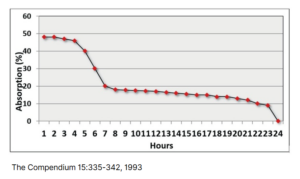乳用ヤギの子供のための初乳の重要性
初乳を適切に管理することは、乳用ヤギの子供の健康と生存にとって極めて重要である。初乳は必須栄養素と免疫保護を提供し、環境病原体から身を守るために必要な自然免疫力を持たずに生まれてくる新生児には不可欠である。ヤギの子供の死亡原因の50%は初乳の不足により最初の24時間以内に起こることを考えると、出生後すぐに高品質の初乳を与えることは、子供の生存を確保するために最も重要です。この記事では、初乳の重要性、その栄養組成、ヤギの子供の初期疾病を予防する上で初乳が果たす重要な役割について述べる。さらに、代替初乳源の使用や、初乳を安全に消費するための初乳汚染に関する注意事項など、初乳管理プロトコルについても説明します。
初乳の栄養成分
- 初乳には、新生児の健康をサポートする栄養素が豊富に含まれています:
- エネルギー(脂肪):体温調節を助け、低体温を防ぐ。タンパク質(免疫グロブリン):IgG抗体は病原体に対する免疫防御に不可欠。
- ビタミン:A、D、Eなどの脂溶性ビタミンは、免疫機能、成長、骨の発育をサポートする。
- ミネラル:カルシウム、セレン、マグネシウムなどの必須元素は、骨格の発達と代謝機能をサポートする。
初乳管理プロトコール:タイミング、量、質
効果的な初乳管理には、初乳の時期、量、質、清潔さを考慮することが含まれる:
1.タイミング:抗体の吸収は、免疫グロブリンのような大きなタンパク質を腸が吸収できる生後数時間が最も効率的である。腸が開いている」期間は24時間までとする文献もあれば、36時間までとする研究もある。しかし、初乳をできるだけ早く、理想的には生後2時間以内に与えることで、免疫力を最大限に高めることができると一般的に言われています。
2.量:量:生まれたばかりの子ヤギには、最初の 24 時間以内に体重の 15 ~ 20% の初乳を与える。これを数回に分けて与えることができ、最初の給餌で体重の 5 ~ 7% を与え、その後目標量に達するまで少量の給餌を続ける。例えば、体重3kgの仔であれば、初回の給与量は150~210mlです。
3.品質:高品質の初乳には、1リットルあたり50グラム以上のIgGが含まれ、Brix屈折計の測定値が25%以上である。中級品質の初乳は、Brixが22~25%の間(約20~50g IgG/L)、低品質の初乳は20g IgG/L以下(Brixが19%以下)です。初乳に十分なIgGが含まれていることは、子供に十分な免疫保護を与えるために不可欠です。

人工栄養法:ボトルまたはチューブ
初乳は、新生児の正常な体温である38.5~39.5℃の体温で与える。ボトルフィーディングは、子供が自然に哺乳できるため望ましい方法ですが、子供が弱くて哺乳できない場合は、チューブフィーディングを使用することもできます。経管栄養は、必要な量を確実に与えることができるが、子供を傷つけたり、誤嚥性肺炎を引き起こしたりしないよう、技術と注意が必要である。生まれたばかりのヤギの子供の胃の最大容量は体重の約7~10%なので、与え過ぎないように注意する必要があります。
ヤギの子供に必要なIgG
新生ヤギの子供が受け取るべき免疫グロブリンG(IgG)の量は、受動免疫の適切な伝達を確保するために非常に重要である。推奨されるIgGの最低摂取量は、体重1kgあたり8.7~13gである。例えば、体重3kgの子ヤギが十分な免疫保護を受けるためには、最初の24時間以内に26.1~39gのIgGを摂取する必要があります。このガイドラインは、IgGの摂取量がこれより少ないと、受動免疫の伝達がうまくいかず、罹患率や死亡率が高くなるという研究結果によって裏付けられている。
ヤギの子供のための代替初乳源
母体の初乳が汚染されていたり、入手できなかったり、不十分であったり、品質が十分でない場合には、代替の初乳源を使用することができる:
1.他のヤギの初乳:入手可能であれば、他の健康な雌ヤギの初乳を使用することができる。余った初乳は、1 回分(200~250 ml)を小分けにして冷凍保存する。凍結した初乳は、栄養分と免疫グロブリン含量を保つため、50℃以下 の温水浴で解凍する。
2.初乳補充剤:市販の初乳補液があり、母体初乳の代用となる。これらの製品は、多くの場合ウシをベースとしており、1リットル当たり少なくとも50gのIgGを供給するように配合されています。これは、高品質のヤギ初乳と同等です。優れた代用品は、子供の血清中のIgG濃度を1リットルあたり15g以上に高め、十分な保護を提供するはずです。
コロストラム使用上の注意
汚染された初乳は新生児に深刻な健康リスクをもたらす可能性があるため、初乳の供給元を選ぶ際には注意が必要である。汚染された初乳は、新生児に深刻な健康リスクをもたらす可能性がある:
- カプリン関節炎性脳炎(CAE)
- マイコプラズマ
- カゼ性リンパ節炎(CL)
これらの病原菌は初乳を通して子供に感染する可能性があり、長期的な健康問題 や死亡の原因になることもあります。これらの病気が懸念される牛群では、初乳を低温殺菌するか、市販の初乳補 充剤を使用するのが最も安全な選択肢かもしれません。
結論とまとめ
結論として、効果的な初乳管理は乳用ヤギの子供の健康と生存に不可欠である。主なポイントは以下の通りです:
- 必要な抗体の吸収を確実にするため、生後2時間以内に高品質の初乳を与える。
- 最初の24時間以内に初乳を体重の15-20%与え、体重1kgあたり少なくとも8.7-13gのIgGを与える。
- 適切な取り扱いを徹底し、汚染された初乳を介した疾病感染を避けつつ、必要に応じて代替初乳源を使用する。
これらのガイドラインを守ることで、ヤギ農家は死亡率を大幅に減らし、牛群の全体的な健康と活力を向上させることができる。
参考文献
Chigerwe, M., Tyler, J. W., et al.乳用ヤギ初乳中のコロストラル免疫グロブリン G 濃度。Journal of Dairy Science, 91(5), 1853-1861.
Weaver, D. M., Tyler, J. W., et al.新生仔牛におけるコロストラル免疫グロブリンの受動的移行。Journal of Dairy Science, 83(5), 924-930.
ブリックス屈折計使用ガイド。(2021).乳用ヤギ管理マニュアル。
USDA.(2020).小型反芻動物の初乳低温殺菌。National Institute of Food and Agriculture.
